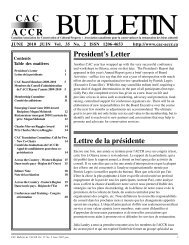Ottawa - Canadian Association for Conservation
Ottawa - Canadian Association for Conservation
Ottawa - Canadian Association for Conservation
Create successful ePaper yourself
Turn your PDF publications into a flip-book with our unique Google optimized e-Paper software.
Burning Questions:<br />
Treatment Considerations <strong>for</strong> a Fire-damaged Sewing Table<br />
Amanda Salmon, Conservator, Intern<br />
<strong>Canadian</strong> Institute <strong>for</strong> <strong>Conservation</strong>, <strong>Ottawa</strong> ON<br />
Alastair Fox, Conservator, Furniture and Decorative Arts<br />
<strong>Canadian</strong> Institute <strong>for</strong> <strong>Conservation</strong>, <strong>Ottawa</strong> ON<br />
In 2008-2009, the Furniture laboratory at the <strong>Canadian</strong> <strong>Conservation</strong> Institute undertook the<br />
treatment of a Victorian sewing table that had been damaged in a fire. Approximately 85% of the<br />
inlaid veneer on the lid and the front of the apron was destroyed, there was localized, superficial<br />
charring of the case substrate, and scorching on the front of the work basket and the base. The<br />
structure of the table was considered quite stable; however, much of the remaining veneer was heavily<br />
soiled, blistered, brittle and/or lifting.<br />
The treatment of the object posed a variety of issues and challenges. While the condition of the lid<br />
was poor, valuable details including tool marks and the ‘ghosts’ of all missing marquetry decoration<br />
were retained in the char. Similarly, the marquetry on the front of the scorched bonnet, blackened<br />
and brittle through its entire thickness, was still relatively complete. The overall condition of the base<br />
was good in comparison, as damage was limited to the front and almost entirely to the finish. Issues<br />
of structural integrity were relatively uncomplicated, but the aesthetic and interpretive integrity of the<br />
object was compromised by the sewing table’s incongruent appearance. Through consultation with the<br />
curator, and considering the potential <strong>for</strong> new research in the area of consolidation of charred wood,<br />
the decision was made to stabilize charred areas, fill losses and return the object to a more complete<br />
appearance.<br />
With very little in<strong>for</strong>mation available regarding the treatment of charred wood, extensive testing<br />
was required to find a suitable resin to consolidate the fragile surface. Charred areas of the substrate<br />
required consolidation with a resin with the strength and flexibility which could accommodate the<br />
inevitable movement of sound adjacent wood in the future, and also, where necessary, bond with inpainting<br />
media, adhesive, fill materials and veneer components. A resin was chosen and a method<br />
<strong>for</strong> the impregnation of localized areas on the oversized object was developed to ensure adequate<br />
penetration of the consolidant.<br />
To replace the missing marquetry, photographic analysis was used to reveal original details. A<br />
marquetry chevalet was constructed and the decorative elements revealed through the photography<br />
were reproduced using traditional techniques. Scaled photographs of the lid be<strong>for</strong>e treatment were<br />
also used to accurately register the new veneer fills adjacent to the original marquetry.<br />
This presentation will discuss both the ethical and technical challenges faced throughout<br />
the treatment and will highlight new methodologies and the use of existing technologies <strong>for</strong><br />
unconventional means.





